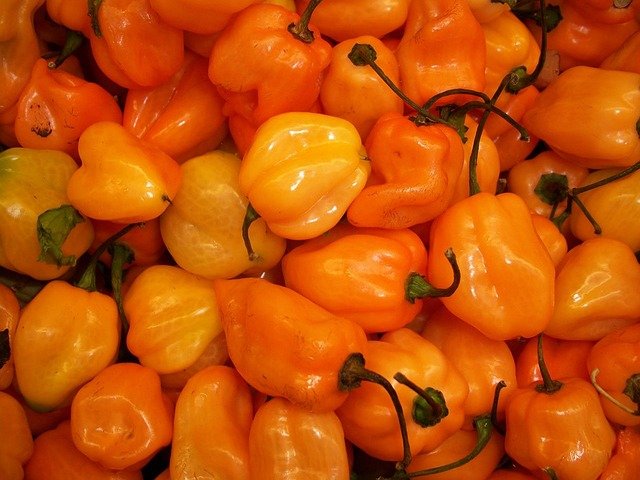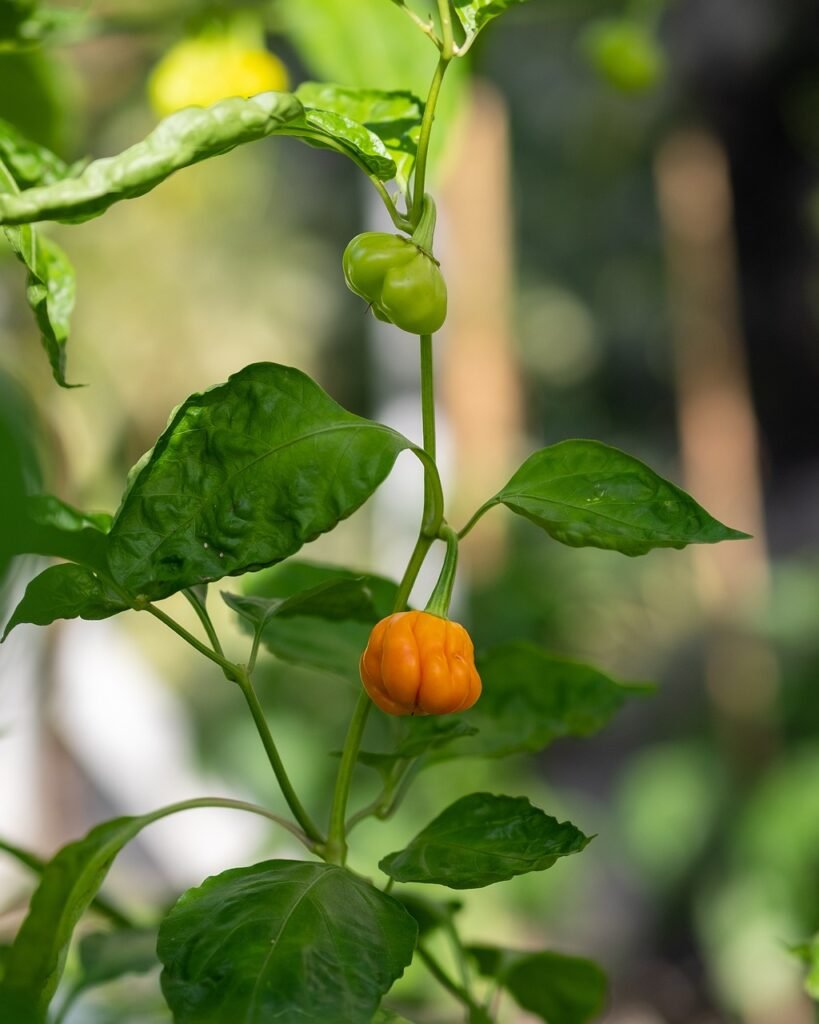Habaneros are known for their fiery heat and vibrant color, and they make a fun project for gardeners of all levels!
But like any plant, there are some things to know before diving in. This guide will walk you through how to grow habanero peppers successfully.
We’ll use simple steps and tips to make sure your first (or next) harvest is a spicy achievement.
Why Grow Habanero Peppers?

Before we dive into the “how to grow habanero peppers” part, let’s talk about the “why.”
Habanero peppers aren’t just hot—they have a unique fruity flavor that can really elevate dishes, especially salsas, sauces, and even marinades.
Growing them yourself gives you control over your harvest, and there’s something extra satisfying about using peppers you grew with your own hands.
Plus, they’re a vibrant and attractive addition to any garden!
Now that you’re hooked on the idea, let’s get into the nitty-gritty of growing habanero peppers.
What You’ll Need to Grow Habanero Peppers
1. Seeds or Seedlings?
You have two options when starting out: planting habanero seeds or purchasing seedlings.
If you’re impatient like I was the first time I grew peppers, you might be tempted to start with seedlings.
This definitely saves some time, but there’s something rewarding about starting from seeds. Growing from seeds takes a bit longer, but you get to see the entire lifecycle of your plants.
If you’re growing from seeds, you’ll want to start indoors about 8 to 10 weeks before the last frost in your area.
For beginners, getting a seed tray with a plastic cover helps create a mini-greenhouse effect to speed up germination.
If you choose seedlings, you can start planting outdoors after the last frost. Either way, the key is patience—habaneros take their time!
2. The Right Soil
One mistake you don’t want to make when growing habanero peppers is underestimating the importance of good soil.
These peppers thrive in well-draining soil that’s rich in organic matter.
If your soil is heavy or clay-like, mix in some compost or potting soil to make it lighter.
The pH level should be slightly acidic, between 6.0 and 6.8.
Quick Tip: You can test your soil with an inexpensive soil tester to make sure it’s just right.
3. Pots or Garden Bed?
While habaneros can grow well in pots, they need plenty of space for their roots. If you’re growing them in containers, use a pot that’s at least 5 gallons in size.
If you’re planting in a garden bed, make sure the plants are spaced about 18 to 24 inches apart.
4. Location, Location, Location

Habanero peppers need full sun—about 6 to 8 hours a day.
In fact, the more sun they get, the better.
You can plant them in a spot that only gets partial sun, and while they will most likely grow, they won’t be nearly as productive as they could have been.
Pick a sunny spot, and your habanero peppers will thank you with more fruit!
Step-by-Step Guide to Growing Habanero Peppers
1. Germinating the Seeds
When it comes to “how to grow habanero peppers,” starting the seeds is the first major step.
If you’re starting from seeds, you’ll need a warm spot inside, like on top of your refrigerator or a sunny windowsill.
Temperature is key: Habanero seeds germinate best in temperatures between 75°F and 90°F. If your home is cool, you might want to invest in a seedling heat mat to help the process along.
Keep the soil moist but not soggy: Water the seeds regularly, but make sure they’re not sitting in water. Too much water can lead to mold or rot.
Be patient: Habanero seeds can take anywhere from 7 to 14 days to germinate, so don’t panic if nothing happens right away.
I know it can be tempting to check the soil daily expecting the seedlings to pop up overnight—trust me, they’ll take their time!
2. Transplanting the Seedlings
Once your habanero seedlings have sprouted and are about 4-6 inches tall, they’re ready to be moved outside. But hold on—don’t rush this process! Transplanting too soon can shock the plants.
Harden off your seedlings: This means gradually exposing them to the outdoors. Start by placing them outside for a few hours each day, increasing the time over about a week.
Plant after the last frost: Habanero peppers are sensitive to cold, so it’s important that all risk of frost has passed.
In most places, this means waiting until late spring or early summer.
Caring for Your Habanero Plants
1. Watering
Habanero peppers like to be watered deeply, but infrequently. It’s important to let the soil dry out between watering, as these peppers don’t like soggy roots.
Watering every 3 to 4 days should be enough, but if you’re in a particularly hot climate, you may need to water more often.
One time, I accidentally overwatered my plants and ended up with root rot on one. The rest survived, but it was a good reminder to let the soil dry out a bit before watering again.
2. Fertilizing
Habanero peppers are heavy feeders, which means they need a lot of nutrients. Use a balanced fertilizer every two weeks, especially when the plants are producing fruit.
If you’re growing habanero peppers in containers, they may need a bit more fertilizer than those planted in the ground since nutrients get used up more quickly in pots.
3. Pruning and Supporting the Plants
Habanero plants can get quite tall—up to 4 feet in some cases—so don’t be surprised if they start leaning.
Use stakes or tomato cages to support the plants as they grow taller. You can also prune some of the lower leaves to encourage better airflow and help prevent disease.
Common Problems and Solutions
1. Pests
Unfortunately, habanero peppers are a favorite snack for pests like aphids and spider mites.
To combat this, keep an eye out for any signs of damage (like curling leaves or tiny dots) and treat the plants with insecticidal soap if needed.
In my experience, a strong spray of water can also dislodge aphids and keep the plants happy.
2. Blossom End Rot
Blossom end rot is when the bottom of your peppers turns black and mushy. This usually happens when the plants don’t get enough calcium, often due to inconsistent watering.
To avoid this, keep your watering schedule regular and consider adding a calcium supplement to the soil if you notice any signs of rot.
3. Sunscald
Since habanero peppers love the sun, you might be tempted to think that more is always better.
But if the peppers themselves are exposed to too much direct sunlight, they can get sunscald, which causes white, papery patches on the fruit.
If you notice this, try to provide some shade for your plants during the hottest part of the day, or plant them near taller crops that can offer a little cover.
Harvesting Your Habanero Peppers

After all that hard work, you’ll be eager to harvest your spicy little gems! Habanero peppers are usually ready for picking about 75-100 days after transplanting.
The peppers will start off green and gradually turn orange, red, or even brown depending on the variety.
How to tell when they’re ready
The best way to know when to pick habanero peppers is by their color. Once they reach their mature color (usually a vibrant orange or red), they’re ready to harvest.
Use scissors or pruning shears to harvest
Habanero peppers can be delicate, so avoid pulling them off the plant by hand. Instead, use scissors or pruning shears to snip them from the plant to avoid damaging the stem.
And be careful when handling your harvest! Habanero peppers are extremely hot, so it’s a good idea to wear gloves or wash your hands thoroughly after picking and handling them.
Enjoying Your Habanero Peppers
Once you’ve learned how to grow habanero peppers, you’ll have a stash of fiery fruit to experiment with in the kitchen.
Whether you’re making hot sauce, adding them to your favorite salsa, or just spicing up a dish, habaneros are a fantastic ingredient to have on hand.
If you feel a bit overwhelmed by a huge harvest, consider freezing or drying your habanero peppers. You can store them for months and keep the heat going all year long!
Final Thoughts
Learning how to grow habanero peppers is a rewarding experience, and with a little patience and care, you’ll have an abundant harvest of these fiery peppers.
Remember, habaneros can be picky about temperature and water, but once you’ve mastered their needs, you’ll be enjoying homegrown heat in no time.
Happy gardening, and good luck with your habanero peppers!
Explore more. Fear less.
- Why Road Trips are One of the Best Ways to Clear Your Mind - November 21, 2024
- 10 of the Best Pumpkin Patches in the U.S. - October 23, 2024
- 10 of the Most Colorful Fall Road Trips in the U.S. - October 22, 2024
